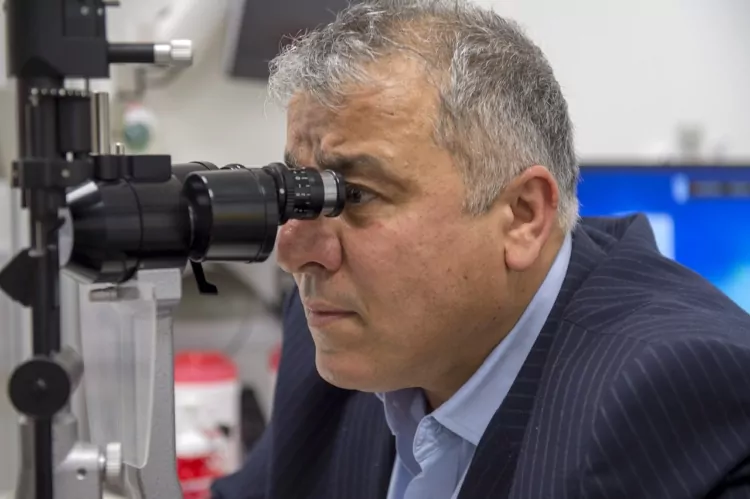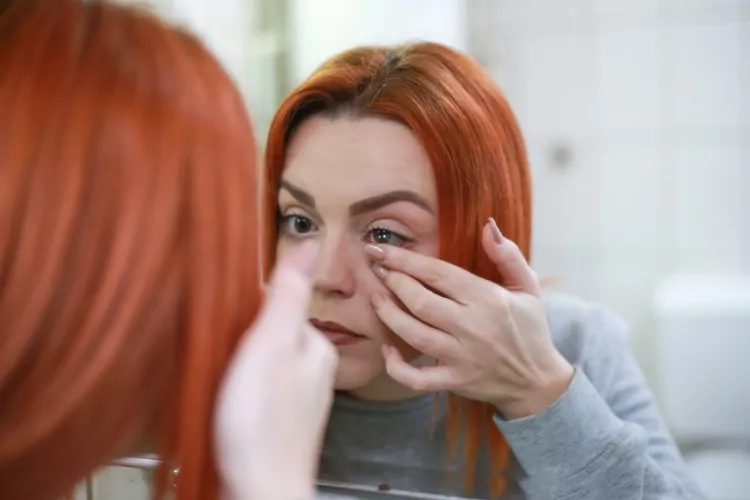One of the most commonly asked questions of patients is, how often should you have an eye test?
Eye exams are essential for maintaining good eye health and detecting potential issues early.
How Often Should You Have an Eye Test?
The frequency of eye tests can vary depending on a person’s age and any existing eye conditions.
Children and Adolescents: Children should have their first eye exam at around 6 months of age, then again at age 3 and before starting school. Afterward, they should have eye exams every 1-2 years during their school years.
Young Adults (Ages 18–40): Generally, young adults with no known eye conditions should have eye exams every 2 years. However, those wearing corrective lenses or with a family history of eye diseases may need more frequent exams.
Adults (Ages 40–64): Adults should have eye exams every 2 years, even if they don’t wear glasses or contacts. Starting around age 40, it’s important to monitor for age-related vision changes, like presbyopia, and early signs of conditions like glaucoma.
Seniors (Ages 65+): Individuals aged 65 and older are usually recommended to have annual eye exams, particularly if they have cataracts or other age-related eye conditions. The risk of age-related eye diseases such as macular degeneration and cataracts increases with age, making early detection crucial. Eyes can also show signs of other medical conditions that can be age-related such as high cholesterol or raised blood pressure. Early detection is crucial to helping treat and manage these conditions.
People with Existing Eye Conditions: Those with existing eye conditions like diabetes, glaucoma, or a family history of eye diseases should follow the recommended schedule of their eye care professional. Often, they require more frequent exams, such as yearly or even more often.
Noticing and addressing eye health issues early is vital for maintaining optimal vision and preventing long-term health problems. It means having regular eye tests is the key to healthy eyes. Many eye conditions, when caught in their early stages, are more manageable and treatable. Regular eye exams are a proactive way to ensure your eyes remain in top condition, promoting not only clear vision but also overall well-being.

Signs You May Need an Eye Test
If you’ve been experiencing persistent issues with your vision or eye comfort, do not wait for your next scheduled eye test, which may be two years away. There are multiple telltale signs that can serve as early indicators of potential eye health problems, demanding more immediate attention. We’ll touch on these below.
Blurry, Fuzzy, or Overall Distorted Vision
One of the most common signs that you may need an eye test is a noticeable decline in the clarity of your vision. If you find that objects appear blurry, fuzzy, or distorted, it could indicate a refractive error such as near-sightedness (myopia), farsightedness (hyperopia), or astigmatism. These conditions can make it challenging to see objects clearly at various distances.
Frequent Headaches or Eye Strain
Frequent headaches, particularly those centred around your forehead and temples, or eye strain after activities like reading, using digital screens, or other close-up tasks, might be linked to uncorrected vision problems. When your eyes struggle to focus properly due to refractive errors, they can become fatigued, leading to discomfort and headaches.
Difficulty Adjusting Your Vision Between Distances
If you find it increasingly difficult to adjust your vision when transitioning from near to far objects or vice versa, it could be a sign of underlying vision issues. Your eyes should be able to adapt smoothly to varying distances. Difficulty in doing so might indicate problems like presbyopia (age-related difficulty focusing on close objects) or other vision changes.
Squinting to See Clearer
Squinting is a natural response to try and improve focus and clarity when your vision is compromised. By partially closing your eyelids, you reduce the amount of light entering your eyes and can temporarily enhance your vision. If you catch yourself squinting frequently to see things more clearly, it’s a significant sign that you should schedule an eye test.
Having Trouble Seeing or Driving at Night
Night vision problems, including glare from headlights, halos around lights, or difficulty seeing road signs and pedestrians in low-light conditions, can be indicative of various eye conditions. Impaired night vision can pose a significant risk, especially for driving, as it impacts your ability to react promptly to road hazards. Meeting the standard vision requirements for driving, as set by organisations like the DVLA (Driver and Vehicle Licencing Agency), is essential for road safety.

Do I Need an Eye Test for Contact Lenses?
If a person is considering using contact lenses, it’s essential for them to undergo a separate eye examination specifically geared towards contact lens fitting. While routine eye exams conducted by an optometrist assess overall eye health and vision, a contact lens fitting exam focuses on determining the right type and fit of contact lenses for an individual’s eyes. Here’s why a separate contact lens examination is necessary:
Precise Prescription: Contact lenses require a precise prescription that may differ from your eyeglass prescription. Contact lenses sit directly on the eye’s surface, so their prescription must account for factors like the curvature of the cornea. During a contact lens fitting exam, the eye care professional will determine the ideal lens power and type for your specific needs.
Eye Health Assessment: Contact lenses can affect the health of your eyes. An eye care professional will assess the health of your eyes, including the cornea and surrounding tissues, to ensure they are suitable for wearing contacts. They will also check for conditions like dry eye syndrome that could impact contact lens comfort.
Lens Type and Fit: There are various types of contact lenses, including soft, rigid gas-permeable, toric for astigmatism, multifocal for presbyopia, and more. The fitting exam helps determine which type and size of lenses are most appropriate for your eyes. Achieving the right fit is crucial for comfort and clear vision.
Proper Handling and Care: The eye care professional will provide instructions on how to insert, remove, clean, and maintain your contact lenses safely. Understanding the is vital for maintaining eye health and minimising the risk of complications.
To streamline the process, you can often schedule your contact lens fitting exam to coincide with your routine optician’s appointment.
Eye Tests for Reading Glasses
Eye exams are essential in determining the need for reading glasses, as they assess various aspects of your vision. Here’s how a routine eye test can help determine the need for reading glasses:
Visual Acuity Testing: Your optometrist will conduct a visual acuity test. This typically involves reading letters or numbers on a standardised chart from a specific distance. If you have difficulty seeing the smaller, near-range letters clearly, it indicates that you may need reading glasses.
Refraction Test: A refraction test helps determine the specific prescription needed for reading glasses. The eye care professional will use a phoropter or trial lenses to determine the lens power that provides you with the clearest vision when reading text up close. This prescription, often expressed as a positive number (e.g., +2.00), indicates the strength of reading glasses required.
Near Vision Assessment: These tests involve reading text or looking at objects at a close distance to assess your near vision. If you struggle to see these objects clearly, it’s a sign that your eyes have difficulty focusing on close-up tasks, which reading glasses can help correct.
Assessment of Presbyopia: Presbyopia is an age-related condition that affects the eye’s ability to focus on close objects. It typically becomes noticeable around the age of 40. During an eye test, your eye care professional may assess for presbyopia by evaluating your near vision and the ability to focus on close objects without straining.
Discussion of Symptoms: Your eye care professional will also inquire about any symptoms you’ve been experiencing, such as eye strain, headaches, or difficulty reading small print. These symptoms can provide valuable insights into your need for reading glasses.
Recommendation and Prescription: Based on the findings of the eye test, your optometrist will recommend and prescribe the appropriate strength of reading glasses if required. The prescription will specify the lens power needed for each eye.
Other Reasons You May Need an Eye Test
While routine eye tests are typically recommended every two years for adults with no known eye conditions, there are certain non-vision-related signs and health conditions that may necessitate more frequent eye tests. These signs and conditions can be detected or monitored through regular eye exams:
Diabetes: Individuals with diabetes are at a higher risk of developing diabetic retinopathy, a condition that affects the blood vessels in the retina. Regular eye tests are essential for the early detection and management of diabetic eye complications. For those with diabetes, annual eye exams are often recommended.
High blood pressure (hypertension): High blood pressure can affect the blood vessels in the eyes, leading to conditions like hypertensive retinopathy. Monitoring the health of the eye’s blood vessels through regular eye exams can help in the early detection of hypertension-related issues.
Glaucoma: Glaucoma is often called the “silent thief of sight” because it typically progresses without noticeable symptoms until significant vision loss occurs. Regular eye exams are crucial for detecting elevated intraocular pressure and early signs of glaucoma, especially for individuals with a family history or other risk factors.
Autoimmune Disorders: Conditions like rheumatoid arthritis, lupus, and multiple sclerosis can have ocular manifestations. Regular eye exams can detect eye-related symptoms and help manage these conditions more effectively.
Medications and Side Effects: Some medications may have ocular side effects, such as dry eyes or changes in vision. If you’re taking medications with potential eye-related side effects, more frequent eye exams may be necessary to monitor your eye health.
Eye Trauma or Surgery History: Individuals who have a history of eye trauma, eye surgery, or specific eye conditions may require more frequent follow-up exams to ensure their eye health remains stable.
Age-Related Eye Diseases: As individuals age, they become more susceptible to age-related eye diseases like age-related macular degeneration (AMD) and cataracts. More frequent eye exams are often recommended for seniors to monitor and manage these conditions.
Family History: If you have a family history of certain eye conditions or diseases, you may be at a higher risk. Your eye care professional may recommend more frequent exams to monitor for early signs or risk factors.
Contact Lens Wear: Contact lens wearers should follow a schedule of regular eye exams to assess eye health, ensure proper lens fit, and reduce the risk of contact lens-related complications.
For more information, visit our information page on various eye conditions.
Optegra: 5-Star Vision Correction Surgery
We are true vision correction specialists, with multiple dedicated eye hospitals located throughout the UK. We offer the latest laser eye surgery, lens replacement and cataract surgery. If you’re searching for vision correction, why not contact us today?
By Author: Alastair Stuart
Alastair has extensive experience in both Laser eye surgery and Cataract Surgery. He has completed over 2000 laser eye surgeries, including more than 1000 SMILE procedures, and over 2000 cataract/lens based surgeries.
